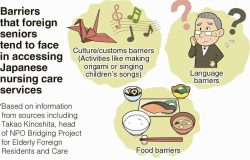
The Seika-tei teahouse in the garden of the Kyoto Sento Imperial Palace in Kamigyo Ward, Kyoto. There is a tearoom for drinking sencha tea in the building.
20:48 JST, November 14, 2022
The salon culture in Paris was at its peak in the late 17th century. Wives of the nobility and upper-class bourgeoisie invited like-minded people to the salons in their residences to enjoy conversations on cultural and academic topics such as literature and art.
A Japanese version of salon culture flourished in Kyoto in the mid-17th century.
One of the best-known is the salon of Emperor Emeritus Gomizunoo (1596-1680). Its venues were mainly the Sento Imperial Palace in Kamigyo Ward, Kyoto, which was built for his post-abdication life, and the Shugakuin Imperial Villa in Sakyo Ward in the city, which was built under his direction and was famous for its spectacular garden.
The salon was hosted by Gomizunoo himself, not his wife, Tokugawa Masako, who later took the name Tofukumon-in.
As her surname suggests, Tokugawa Masako was the fifth daughter of Tokugawa Hidetada, the second shogun of the Edo shogunate. Her marriage with the emperor was arranged to improve the relationship between the shogunate and the Imperial court.
After the emperor abdicated, she had her own palace — today’s Kyoto Omiya Imperial Palace — next to his Sento Imperial Palace.
Most of the construction of the palaces and villa was paid for by the shogunate.
As she also had cultural figures as guests at her palace, it can be said that she also hosted her own salon. She was a known fashion leader, contributing to the promotion of kimono culture. Backed by the enormous economic power of her parents’ family, she had kimono shops in Kyoto make a huge number of kimonos according to her aesthetic sensibility.
But let’s return to Gomizunoo.
In France, salons were a place for socializing. Their regulars mainly belonged to the aristocracy and bourgeoisie, the same class as their hosts. Literary figures and scholars from lower classes did participate at the invitation of their hosts. But I assume they hardly felt relaxed there.
Gomizunoo’s salon started as regular lessons on various arts, which he took alongside his close aides.
Gomizunoo was particularly enthusiastic about ikebana flower arranging. Records say that at an ikebana event on July 7, 1629, his own arrangements were among the 49 exhibits.
His ikebana teacher was Ikenobo Senko II. The Ikenobo family has held the position of head of its school of flower arranging for many generations, right up to today. The flower arrangement event, which was initially held on July 7, is still held today, although the date has been changed due to the limited variety of flowers available in summer.
Gomizunoo also loved to write waka poems. His personal collection, “Gomizunoo-in Gyoshu,” contains about 2,000 poems, and he is regarded as a first-class poet.
Gomizunoo’s company thus included artists of various genres, such as poetry, flower arranging, tea ceremony and calligraphy. His close aides, and later his sons and daughters, joined in to have fun together.
Tea was served in a teahouse built in the garden. Parties with alcohol were held on a floating boat on the pond or on an islet in the pond, where participants created and recited poems, and sang parts of noh plays. They also sometimes played board games such as sugoroku, igo and shogi.
Gomizunoo’s salon started as a forum for cultural activities and gradually shifted to gatherings expressly for pleasure. The trend resulted in interactions among people from different social classes, including not only court nobles but also samurai, townspeople and literati. This was a major characteristic of his salon and the entire salon culture of Kyoto as well.
After Gomizunoo died, Kyoto’s salon culture declined. In its place, the culture of gardens in daimyo residences started to flourish in Edo (present-day Tokyo) — but that’s another story.
"JN Specialities" POPULAR ARTICLE
-

The Japan News / Weekly Edition (12/12-12/18)
-

English-language Kabuki, Kyogen Entertain Audiences in Tokyo; Portland State University Professor Emeritus, Graduates Perform
-

Noodle Dining Shunsai / Rich Oyster Ramen to Savor at Odasaga; Experienced 68-year-old Owner Creates Numerous Ramen Varieties
-

The Japan News / Weekly Edition (12/5-12/11)
-

People Keep Loved Ones’ Ashes Close in Special Jewelry, Small Urns as Unique Way to Memorialize Them
JN ACCESS RANKING
-

Keidanren Chairman Yoshinobu Tsutsui Visits Kashiwazaki-Kariwa Nuclear Power Plant; Inspects New Emergency Safety System
-

Imports of Rare Earths from China Facing Delays, May Be Caused by Deterioration of Japan-China Relations
-

University of Tokyo Professor Discusses Japanese Economic Security in Interview Ahead of Forum
-

Tokyo Economic Security Forum to Hold Inaugural Meeting Amid Tense Global Environment
-

Japan Pulls out of Vietnam Nuclear Project, Complicating Hanoi’s Power Plans

























